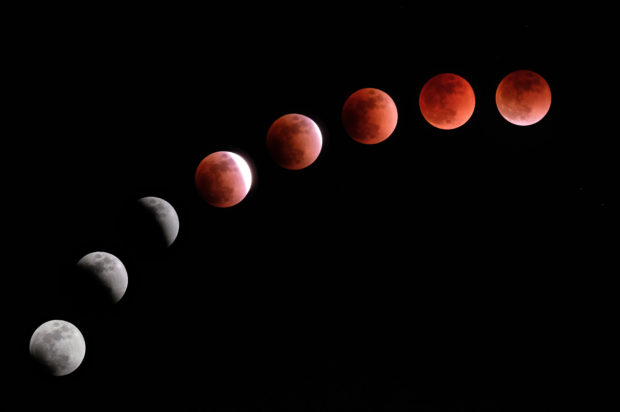Earth awaits longest blood moon

DOUBLE TREAT This composite image created on Jan. 31 shows the moon during a lunar eclipse in Tokyo. On Friday, the longest blood moon eclipse will coincide with Mars’ closest approach to Earth in 15 years in a thrilling astronomical double bill. —AFP
Filipinos will have to hope for clear skies at dawn on Saturday to watch the longest blood moon eclipse this century, according to the Philippine Atmospheric, Geophysical and Astronomical Services Administration (Pagasa).
The eclipse will coincide with Mars’ closest approach to Earth in 15 years to offer skygazers a thrilling astronomical double bill on July 28, astronomers say.
But with cloudy skies across the Philippines forecast for the whole week and a southwest monsoon, weather forecasters are not optimistic Filipinos will get a good view of the eclipse.
“Literally, it’s almost like ‘suntok sa buwan’ (nearly impossible),” Mario Raymundo, chief of Pagasa’s astronomical observation and time service unit, said of the chances the country will be able to see the rare celestial phenomenon.
Saturday’s blood moon is the second this year. The first lunar eclipse, a “super blood moon” occurred on Jan. 31.
Reddish hue
Astronomers call a total lunar eclipse a blood moon because of the reddish hue the full moon takes on when fully eclipsed.
A total lunar eclipse happens when Earth takes position in a straight line between the moon and sun, blotting out the direct sunlight that normally makes our satellite glow whitish-yellow.
The moon travels to a similar position every month, but the tilt of its orbit means it normally passes above or below the Earth’s shadow. So most months we have a full moon without an eclipse.
When the three celestial bodies are perfectly lined up, however, the Earth’s atmosphere scatters blue light from the sun while refracting or bending red light onto the moon, usually giving it a rosy blush.
Color can vary
This is what gives the phenomenon the name blood moon, though Mark Bailey of the Armagh Observatory in Northern Ireland said the color could vary greatly.
It depends partly on “how cloudy or transparent those parts of the Earth’s atmosphere are which enable sunlight to reach the moon,” Bailey told Agence France-Presse (AFP).
“During a very dark eclipse the moon may be almost invisible. Less dark eclipses may show the moon as dark grey or brown … as rust-colored, brick-red, or, if very bright, copper-red or orange.”
In the Philippines, the lunar eclipse will occur on early Saturday dawn, starting at about 1:14 a.m. and will last for about 103 minutes, Raymundo said.
The long duration of this eclipse is partly due to the fact that the moon will make a near-central passage through Earth’s umbra the darkest, most central part of the shadow.
The moon will also be at the farthest point on its orbit from Earth, making its movement across the sky slower from our perspective, thus spending longer in the dark.
Mars near moon
At the same time, Mars will hover near the moon in the night sky, easily visible with the naked eye.
The neighboring planet will appear unusually large and bright, a mere 57.7 million kilometers from Earth on its elliptical orbit around the sun.
“We have a rare and interesting conjunction of phenomena,” Pascal Descamps, an astronomer with the Paris Observatory, told AFP.
“We should have a coppery red tint on the moon with Mars the ‘Red Planet’ just next to it, very bright and with a slight orange hue itself,” he said.
Best view
Pagasa astronomers said they would set up a viewing telescope at the observatory in Quezon City, but were not optimistic they would get to observe the eclipse in its full glory, even with state-of-the-art lenses.
“The moment clouds enter the picture, we lose our chance,” Raymundo said.
With a clear sky, it is best to view the blood moon in coastal areas with a clear view of the moon setting in the west.
In Metro Manila, Manila Bay will have one of the best vistas, he said.
Penumbral eclipse, or that moment when the Earth’s shadow begin to touch the moon’s face, will start at 1:14 a.m., but partial eclipse starts at around 2:24 a.m.
‘Maximum eclipse’
But the total lunar eclipse will happen at 3:30 a.m. and will peak at 4:21 a.m., also known as the “maximum eclipse,” or when the moon is closest to the center of the shadow, according to Raymundo.
“Our best window will be around 3 a.m. to 5 a.m., when the moon really turns reddish. Beyond that, the view of the moon will already be affected by twilight,” he said.
Astronomers predict that the partial lunar eclipse will end at around 6:19 a.m., but this is no longer visible as the moon will set at 5:44 a.m.
The next total lunar eclipse happens on Jan. 21, 2019, according to Pagasa. —Reports from Melvin Gascon and AFP